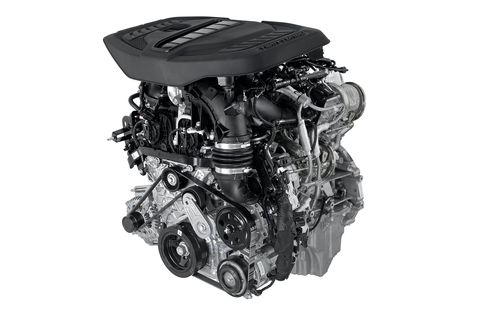- Stellantis’s all-new twin-turbocharged 3.0-liter inline-six, called the Hurricane, should find its way under the hood of various models for the 2023 model year, potentially from the Jeep Wrangler to the Ram 1500 and Dodge Charger and Challenger.
- It’ll be offered in standard-output and high-output variants, and it will fit into any vehicle currently sold that has a longitudinal engine.
- Production has already begun at Stellantis’s Saltillo South engine plant in Mexico.
From battery technology to powerful compact electric motors, headlines surrounding electrification seem to be all the buzz these days. While we have an undeniable interest in the future of electrified propulsion systems, the engineering feat of a clean-sheet internal-combustion engine is a breath of fresh air. Though other automakers have ambitious goals of going fully electric by 2030, Stellantis has identified the need for gasoline-fueled engines in the future, and the company’s goal of being 50 percent electrified in North America by that time seems more realistic. Enter the Hurricane: a twin-turbocharged 3.0-liter inline-six.
The new powerplant will fit into any vehicle currently sold that has a longitudinal engine. When the Hurricane arrives under the hood of various Stellantis-brand vehicles within the next year, the double-overhead-camshaft, direct-injected inline-six will have bore and stroke measurements of 84.0 millimeters and a 90.0 millimeters. Its cylinders are spray bored using a plasma transfer wire arc process that adds a thin iron coating to the cylinder walls, which Stellantis claims saves three pounds versus using a more traditional iron sleeve. Those bore and stroke figures are identical to BMW’s potent S58 3.0-liter inline-six that powers the M brand and also follows the same approach of having each turbo fed by three cylinders to minimize turbo lag. The Hurricane will be offered in standard-output and high-output variants.
Stellantis says the standard-output engine will deliver more than 400 horsepower and 450 pound-feet of torque, with the final output figures to be determined by the individual brands utilizing the new mill. The lesser-power version has a 10.4:1 compression ratio, and its intake charge is pressurized by the twin turbos with up to 22.4 pounds of boost before being chilled by a water-to-air intercooler. The junior 3.0-liter will rev to 5800 rpm and operate on 87 octane, though 91 is recommended.
The high-output version is set to deliver more than 500 horsepower and 475 pound-feet of twist, putting it on par with BMW’s strongest six-cylinder offering. The compression ratio is lowered to 9.5:1 to accommodate the 26.0 psi delivered from the larger turbos through a dual-inlet intake. The high-output engine features its own cylinder head, crankshaft, larger water-to-air intercooler, and forged aluminum pistons (vs. the standard-output’s cast pieces) and will rev slightly higher, to 6100 rpm, although well off the glorious 7200-rpm wail of BMW’s singing six. To generate all this wonderful power, 91 octane will be required.
These engines could be used for a number of Stellantis products such as the Jeep Gladiator, Grand Cherokee, Wagoneer, Grand Wagoneer, and Wrangler; the Ram 1500 and 2500; and the Dodge Challenger and Charger. If we were to speculate, we’d say the new inline-six will replace the classic—albeit wildly inefficient—V-8s we’ve grown to love and the venerable Pentastar 3.6-liter V-6, but Stellantis declined to say just that. Nevertheless, we’re excited to get our hands on the Hurricane in the months to come.
This content is imported from {embed-name}. You may be able to find the same content in another format, or you may be able to find more information, at their web site.
This content is created and maintained by a third party, and imported onto this page to help users provide their email addresses. You may be able to find more information about this and similar content at piano.io

